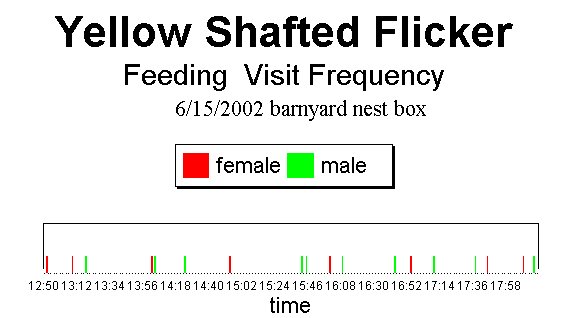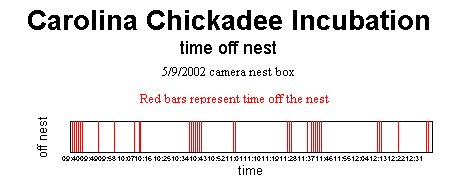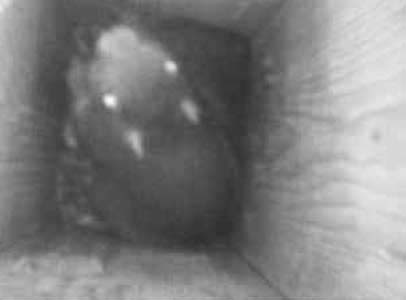
Observations and studies using nest box cameras

Incubation and brooding
The amount of time invested in these duties can be recorded both by their frequency and duration. One easy way to do this is to enter data in a spreadsheet while viewing the videotape, noting the exact time each incubation segment begins and ends. The video should be previewed first to get an idea of the variety of activity encountered and plan your data entry accordingly. For example, the female chickadee in my video frequently would step off the nest, but not leave the box. Does this constitute a break in incubation if it is only for 6 seconds? Or if for 2 minutes? Also, she would frequently abruptly leave the nest, only to return in less than 1 minute. She had been called by the male, who brought her a caterpillar on a branch near the nest box. More frequently, he brought her snack to the entrance and she jumped up and accepted it in less than 5 seconds. Decide what you want to record as an interruption in incubation or brooding
before beginning the task of data entry.
 Record the exact time
Record the exact time
If you can superimpose the exact time on your videotape either while recording from the camera or while copying the tape later, you will be able to view in fast forward and start and stop as often as you wish. However, if you must rely on using only the exact start time of the tape and setting a clock to that time as you begin viewing the tape, the clock must be stopped each time you pause the tape to make more popcorn. Any electric dial clock works fine for this purpose, since it can simply be unplugged whenever you pause the tape. And, of course, fast forward cannot be used with this method.
Record the ambient temperature and any other weather parameters possible.
Frequent monitoring of the temperature is almost essential in trying to make sense of any incubation and brooding data. While I have assembled numerous chart recorders, thermocouples and other sensors over the years, the cheap modern digital thermometers with remote sensors are quite accurate and cost less than $10. Of course, without a chart recorder or data logger, you will have to monitor the thermometers as frequently as possible.
Male vs female contribution to incubation, brooding, feeding
The relative contribution to incubation, brooding or nest guarding and feeding by the male and female is an interesting study. Species must be sexually dimorphic with the sexes readily distinguished in black and white video so that each nest box visit can be counted. Two examples are the kestrel and flicker. In the case of the flicker, at some point during a nest box visit, the adult will tilt its head upward toward the top mounted camera to reveal the presence or absence of the maleís moustache. The sex of bluebirds and barn swallows can often also be determined. Barn swallow tail length can often be an identifier for the sexes of a particular pair.
When attributing provisioning of the nestlings to either adult, care must be taken to ascertain what is happening outside the nest box. For example, as kestrel nestlings reach the point where brooding is not necessary, the female begins providing most of the prey. However, when the camera indicates that she leaves the nest for only one or two minutes and returns with a vole, it is likely that the male actually brought the prey to a nearby perch, called to the female, and passed off the prey to her at the perch. During the first few days after the female begins to spend time away from the nest, the male often simply drops a vole into the box, although he usually enters the box, but does not prepare the meal and feed the nestlings. The female will often later find the uneaten prey and tear it apart to feed the nestlings.

Nest box predation and usurpation
One of the more exciting benefits of running continuous videotape in a nest box is catching predators in the act. Chipmunks, flying squirrels, black rat snakes, house wrens, house sparrows, and starlings may all have their moment in the spotlight (infrared in this case) and the humans will no longer have to wonder what happened to their precious bluebird family. And, each morning when the occupants of your nest box have made it safely through the night, the 6 hour videotape can simply be reused. The grey squirrel (right) has taken over a flicker box.
Nestling interactions
The top mounted nest box camera is an ideal way to observe nestling interactions. Each species seems to be a whole new world in this respect. Owls and hawks appear to have the most civilized children. Flicker nestlings go through a phase of intense competition and then calm down again for the remainder of their development. Tree swallow nestlings can be quite competitive, perhaps resulting in higher runt mortality than many other species (my anecdotal observations only). Nestling competition may be strongly linked to availability of food and may vary from nest to nest. For example, the chickadee nestlings in 2002 were not at all aggressive and caterpillars were brought to the nest in greater numbers than the young could consume. At the same time, the cold wet weather made for slim pickings for the tree swallows and their young were quite competitive. Observing nestlings of the same species under different weather conditions and availability of prey would be interesting. Again, keeping weather records for all nest box videos may prove useful even when the immediate value isnít apparent.
Nestling behavior also varies greatly with age. For instance, when the young begin to hop up to the entrance hole to be fed, they then gain control of who is fed. The adults simply feed whoever is blocking the hole. Looking at the turn over rate of this coveted entrance hole position would be interesting.
Prey item identification
The top mounted nest box camera is NOT a useful tool for identifying the types of prey brought to the young since only some of the nest box visits will allow prey identification. The kestrel cam usually allowed identification of the meadow vole from a fleeting glimpse of the hind quarters with short tail as the adult dropped to the bottom of the box. However, she would loom over the prey, holding it down with one foot as she tore off bits to feed the young, completely hiding the carcass from view. Insects were quickly fed in one bite, and identification to order was usually not possible. Feathers are sometimes removed from songbirds before they are brought to the nest, making bird prey less obvious. Bluebird prey can often be identified as caterpillar or large winged insect, but a camera mounted outside the nest box at a right angle to the entrance might be more useful for this purpose. A side view of the adult as it lands at the entrance usually shows the prey in its mouth quite well.
 Oct 2003 update A prey cam mounted outside the barn owl nest box this summer proved useful in recording the type of prey brought to the nestlings. Eye level views, both inside and outside the nest box were fascinating, compared to the top down video of previous years. Preliminary barn owl prey data can be found in the 2003 barn owl cam section
Oct 2003 update A prey cam mounted outside the barn owl nest box this summer proved useful in recording the type of prey brought to the nestlings. Eye level views, both inside and outside the nest box were fascinating, compared to the top down video of previous years. Preliminary barn owl prey data can be found in the 2003 barn owl cam section
Winter roost video
The use by bluebirds of nest boxes for winter roosts has been well documented. However, the extent to which bluebirds use winter roost boxes is not known. Our bluebirds pop in and out of the nest boxes in family groups of 5-8 individuals throughout the fall, however, they seldom actually spend the night in the boxes. Others find that a pair of bluebirds may spend most winter nights in a nest box in their yard. One would guess the weather is the prime factor in determining when nest box shelter is sought. Also, bluebirds in different yards will have different options for shelter. For example, our property has hundreds of Eastern red cedar trees, many of which harbor a great variety of song bird species in their dense foliage each night. This may be why our bluebirds seldom use the winter roost boxes or nest boxes in winter.
The log box with cam mount (right) is offered as a winter roost for downy woodpeckers, but has not yet been used, even though a male downy frequents this tree.
Leaving the camera in your nest box during winter is an easy and unobtrusive way to monitor for winter usage. Checking the monitor once each evening will reveal any use, since the bluebirds will enter at dusk and remain until the next morning. If bluebirds use the box in winter, keeping a record of temperature, wind speed and precipitation may demonstrate a pattern of usage. And, even less is known about winter nest box use by other cavity nesting species, so donít forget the chickadees, titmice and woodpeckers. Also, flying squirrels, white footed mice, and a few other creatures may use your nest box, depending on your location, the entrance hole size, and the habitat surrounding the nest box. Mice will usually build a nest that will block the camera's view. Either trapping the mouse or moving the nestbox will free it up for use by other species.
American Artifacts home
email richard@americanartifacts.com
© 2010, American Artifacts and Richard Van Vleck, Taneytown, Maryland.



 Record the exact time
Record the exact time
 Oct 2003 update A prey cam mounted outside the barn owl nest box this summer proved useful in recording the type of prey brought to the nestlings. Eye level views, both inside and outside the nest box were fascinating, compared to the top down video of previous years. Preliminary barn owl prey data can be found in the 2003 barn owl cam section
Oct 2003 update A prey cam mounted outside the barn owl nest box this summer proved useful in recording the type of prey brought to the nestlings. Eye level views, both inside and outside the nest box were fascinating, compared to the top down video of previous years. Preliminary barn owl prey data can be found in the 2003 barn owl cam section